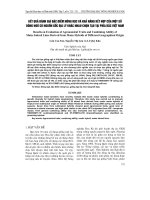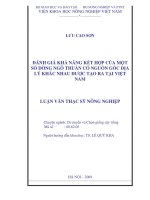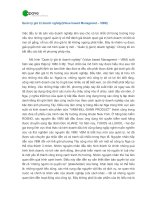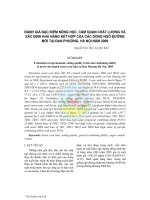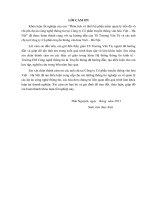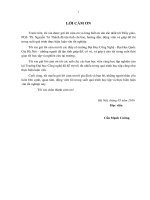Veritas prep GMAT reading comprehension
Bạn đang xem bản rút gọn của tài liệu. Xem và tải ngay bản đầy đủ của tài liệu tại đây (6.43 MB, 276 trang )
Brian Galvin
Chris Kane
Reading
Comprehension
Authors
Brian Galvin
Chris Kane
Co-founders
Markus Moberg
Chad Troutwine
Contributing Writers
David Newland
Ashley Newman-Owens
Contributing Editor
Jodi Brandon
Cover Design
Nick Mason
Interior Design
Tom Ahn
Dennis Anderson
ALL RIGHTS RESERVED. Printed in the U.S.A.
Third Edition, Copyright © 2013 by Veritas Prep, LLC.
GMAT® is a registered trademark of the Graduate
Management Admissions Council, which is not affiliated with
this book.
No part of this publication may be reproduced, stored in
a retrieval system, or transmitted in any form or by any
means, electronic, mechanical, photocopying, recording, or
otherwise without the prior written permission of Veritas
Prep, LLC.
All the materials within are the exclusive property of Veritas
Prep, LLC. © 2013.
Print Batch 2013.1
This book is dedicated to Veritas Prep’s instructors, whose enthusiasm and experience
have contributed mightily to our educational philosophy and our students’ success.
It is also dedicated to the teachers who inspired Veritas Prep’s instructors. The lesson
that follows was only made possible by a lifelong love of learning and of undertaking
educational challenges; we have teachers around the world to thank for that.
Finally and most importantly, this book is dedicated to our thousands of students, who
have taught us more about teaching and learning than they will ever know. And to you,
the reader, thank you for adding yourself to that group.
Personal Dedications
Veritas Prep is a community of educators, students, and support staff, and these books
would not be possible without our cast of thousands. We thank you all, but would like to
specifically acknowledge the following people for their inspiration:
Bogdan Andriychenko (GMAT Club), Clay Christensen (Harvard Business School), Tom
Cotner (Plymouth-Salem High School), David Cromwell (Yale School of Management),
Henry Grubb (Fort Osage High School), Dana Jinaru (Beat the GMAT), Steven Levitt
(University of Chicago), Walter Lewin (Massachusetts Institute of Technology), Lawrence
Rudner (Graduate Management Admissions Council), Jeff Stanzler (University of
Michigan), and Robert Weber (Kellogg School of Management).
TABLE OF CONTENTS
PREVIEW . . . . . . . . . . . . . . . . . . . . . . . . . . . . . . . . . . . . . . . . . . . . . . . . . . . . . . . . . . . . . . . . . . 7
How This Book Is Structured. . . . . . . . . . . . . . . . . . . . . . . . . . . . . . . . . . . . . . . . . . . . . . . . . . . 8
LESSON. . . . . . . . . . . . . . . . . . . . . . . . . . . . . . . . . . . . . . . . . . . . . . . . . . . . . . . . . . . . . . . . . . . 13
Introduction to Reading Comprehension. . . . . . . . . . . . . . . . . . . . . . . . . . . . . . . . . . . . . . 13
Reading Comprehension and the Veritas Prep Pyramid . . . . . . . . . . . . . . . . . . . . . . . . 14
SECTION 1: Reading Comprehension Basics . . . . . . . . . . . . . . . . . . . . . . . . 15
Types of Passages.............................................................................................................17
SECTION 2: “STOP” Reading Strategy. . . . . . . . . . . . . . . . . . . . . . . . . . . . . . . . 19
More on Reading style and Strategy.........................................................................21
Applying STOP Strategy.................................................................................................25
Scope of the Passage......................................................................................................25
The Author’s Tone............................................................................................................27
Organization......................................................................................................................31
Purpose................................................................................................................................35
STOP Reading Strategy Summary...............................................................................39
SECTION 3: Mastering THE common question types . . . . . . . . . . . . . . . 41
General Strategies for Reading Comprehension Questions..............................43
Specific.................................................................................................................................45
Inference..............................................................................................................................49
Function...............................................................................................................................53
Universal..............................................................................................................................57
Mastering the Common Question Types Summary.............................................63
SECTION 4: Advanced reading comprehension subjects. . . . . . . . . 63
Natural Sciences Passage.............................................................................................. 66
Technical Passage............................................................................................................ 86
Advanced Reading Comprehension Subjects Summary................................. 105
HOMEWORK . . . . . . . . . . . . . . . . . . . . . . . . . . . . . . . . . . . . . . . . . . . . . . . . . . . . . . . . . . . . 106
Answer key. . . . . . . . . . . . . . . . . . . . . . . . . . . . . . . . . . . . . . . . . . . . . . . . . . . . . . . . . . . . 253
table of contents
CR E ATING Think Like the Testmaker
Creating is the top of the pyramid in Bloom’s Taxonomy. When you have completely mastered
the GMAT, you are able to Think Like the Testmaker. You are on top of the pyramid looking down!
You don’t just have good content knowledge and lots of practice with GMAT problems; you
understand how a problem has been made, what makes it hard, and how to break it down. When
you Think Like the Testmaker you can:
1.
Quickly recognize what the problem is actually asking,
2.
Discover hidden information and manipulate it to make it useful,
3.
Recognize and see through trap answers, and
4.
Create your own plan of attack for any problem.
APPLYING Skills Meet Strategy
What makes the GMAT difficult is not so much the underlying skills and concepts, but rather the
way those skills and concepts are tested. On the GMAT, what you know is only as valuable as
what you can do with that knowledge. The Veritas Prep curriculum emphasizes learning through
challenging problems so that you can:
1.
Learn how to combine skills and strategies to effectively solve any GMAT problem,
2.
Most effectively utilize the classroom time you spend with a true GMAT expert, and
3.
Stay focused and engaged, even after a long day in the office.
R E M E M BE R ING Skillbuilder
In order to test higher-level thinking skills, testmakers must have some underlying content from
which to create problems. On the GMAT, this content is primarily:
•
Math curriculum through the early high school level, and
•
Basic grammar skills through the elementary school level.
To succeed on the GMAT you must have a thorough mastery of this content, but many students
already have a relatively strong command of this material. For each content area, we have
identified all core skills that simply require refreshing and/or memorizing and have put them in
our Skillbuilder section. By doing this:
1.
Students who need to thoroughly review or relearn these core skills can do so at their
own pace, and
2.
Students who already have a solid command of the underlying content will not
become disengaged because of a tedious review of material they’ve already mastered.
preview
PREVIEW
preview
As you learned in the Foundations of GMAT Logic lesson, the educational philosophy at
Veritas Prep is based on the multi-tiered Bloom’s Taxonomy of Educational Objectives,
which classifies different orders of thinking in terms of understanding and complexity.
To achieve a high score on the GMAT, it is essential that you understand the test from
the top of the pyramid. On the pages that follow, you will learn specifically how to
achieve that goal and how this lesson in particular relates to the Veritas Prep Pyramid.
7
How This Book Is Structured
Our Curriculum Is Designed to Maximize Your Time
The Veritas Prep Teaching Philosophy: Learning by Doing
Business schools have long featured the Case Method of education, providing students
with real-world problems to solve by applying the frameworks they have studied. The
Veritas Prep Learning by Doing method is similar. In class, you will spend your time
applying skills and concepts to challenging GMAT problems, at the same time reviewing
and better understanding core skills while focusing your attention on application and
strategy. The Case Method in business school maximizes student engagement and
develops higher-order thinking skills, because students must apply and create, not just
remember. Similarly, the Learning by Doing philosophy maximizes the value of your
study time, forcing you to engage with difficult questions and develop top-of-thepyramid reasoning ability.
An important note on Learning by Doing: In business school, your goal with a
business case is not to simply master the details of a particular company’s historical
situation, but rather to develop broader understanding of how to apply frameworks
to real situations. In this course, you should be certain to reflect on each question not
simply through that narrow lens (Did you answer correctly? What key word made the
difference?), but rather as an example of larger GMAT strategy (How could the exam
bait you with a similar trap? How deeply do you need to understand the content to
solve this genre of problem more efficiently?).
8
preview
How This Book Is Structured
As you learned in the Foundations of GMAT Logic lesson, there are
important recurring themes that you will see in most GMAT problems:
•
•
•
•
•
•
•
Abstraction
Reverse-Engineering
Large or Awkward Numbers
Exploiting Common Mistakes
Selling the Wrong Answer and Hiding the Correct Answer
Misdirection
Content-Specific Themes
Skills M eet Strategy
•
•
•
Guiding Principles
Problem-Solving Strategies
Leveraging Assets
9
preview
Th in k Like th e Testmaker
remember : Don’t mistake
activity for achievement!
Focus on recurring themes,
not just underlying content.
Each book in the Veritas Prep curriculum contains four distinct sections:
1.Skillbuilder. We strongly suggest that you complete each Skillbuilder
lesson before class at your own pace, and return to the Skillbuilder when you
recognize a content deficiency through practice tests and GMAT homework
problem sets.
The Skillbuilder section will:
•
Cover content that is vital to your success on the GMAT, but is best
learned at your own pace outside the classroom.
•
Allow you to review and/or relearn the skills, facts, formulas, and content
of the GMAT. Each student will have his own set of skills that are “rusty” or
even brand-new, and will find other items that come back quickly.
•
Vary in length significantly for each book, based on the number of
underlying concepts. (For instance, the Advanced Verbal lesson does
not have a Skillbuilder because you are already building on the concepts
introduced in three previous lessons.)
2.Lesson. The lessons are designed to provide students with maximum value
added from an instructor by:
•
Doing in-class problems together (Learning by Doing), and
•
Analyzing those problems for the recurring takeaways.
With each problem, there will be a detailed explanation that will help you
understand how the problem is testing a particular concept or series of
concepts, what makes the problem hard, and what underlying skills are
required to solve it.
When relevant, there will be particular boxes for Think Like the Testmaker,
Skills Meet Strategy, and Skillbuilder when you should be focused on
particular aspects of how the question is made or how the underlying
content is being tested.
N ote : When doing in-class and homework problems, you should do your
work below the problem, and you should not circle the answer on the
actual question (just note it on the bottom of the page). That way, if you
want to redo problems, you can simply cover up your work and proceed
as if you had never done it.
10
preview
How This Book Is Structured
3.You Oughta Know. The You Oughta Know sections will round out each lesson
and cover:
Obscure topics that arise infrequently.
•
More advanced topics that are not common on the GMAT but do get
tested.
While these uncommon content areas do not warrant in-class time, we
believe you should have some exposure to these topics before taking the
GMAT. Therefore you should complete these sections before moving to
the homework problems. As with the Skillbuilders, the length of these will
vary depending on their importance.
preview
•
4.Homework Problems. In many ways, the homework problems are the most
important part of each book. After refreshing core content in the Skillbuilder
and then applying that knowledge in the lesson, you must reinforce your
understanding with more problems.
Each question is accompanied by a detailed explanation in your online
student account, as well as a quick-reference answer key on the last page.
A majority of questions are above the 50th percentile in difficulty, and they
are arranged in approximate order of difficulty (easiest to most difficult). By
completing all of the homework problems, you will learn all of the different
iterations of how concepts and skills are tested on the GMAT.
Homework problems are designed to be challenging, so do not despair if
you are answering questions incorrectly as you practice! Your goal should
be to learn from every mistake. Students can miss a significant percentage of
questions in each book and still score extremely high on the GMAT, provided
that they learn from each problem. Embrace the challenge of hard problems
and the notion that every mistake you make in practice is one that you will
know to avoid on the GMAT when every question counts.
11
12
LESSON
LESSON
Introduction to Reading Comprehension
With reading comprehension, the GMAT is testing an essential skill in business: your
ability to scan through dense materials and recognize the significant and relevant
information. In business school and beyond, this will be important not only in your
daily reading of major newspapers, but also in your ability to sort through tedious
business documents and correspondence. Time is at a minimum in the fast-paced
business world, and reading efficiently and effectively is arguably the most important
skill tested on the GMAT.
At first glance, Reading Comprehension questions might seem like the most familiar
of the question types on the GMAT. Everyone has been reading since first grade, and
reading comprehension is a part of almost all the major standardized tests. But reading
on the GMAT is not pleasure reading; it takes concentration and discipline to focus
on the often-convoluted passages about unusual and unfamiliar topics. This exercise
is designed to reward those who can efficiently sort through technical jargon and
unimportant details to find the relevant takeaways.
LESSON
To do that effectively, you must adapt your reading strategy to the task at hand. In this
lesson, you will learn how to do that with the STOP reading strategy. This essential
strategy keeps you from getting bogged down in difficult passages and allows you to
save time for the more challenging, detail-oriented questions. These questions typically
force you to go back to the passage and carefully analyze a sentence or paragraph. In
the third section of the lesson, you will focus on how to contend with these different
question types and how to recognize common traps and tricks used by testmakers to
make them hard.
On the GMAT, success on Reading Comprehension depends on two major components
that will be the focus of this lesson:
•
Your ability to read through the passage efficiently, and retain the core
information and structure of the passage, and
•
Your ability to answer difficult detail-oriented questions that rely on a careful
interpretation of specific information in the passage.
13
Reading Comprehension and the Veritas Prep Pyramid
With Reading Comprehension, the primary underlying skill is something that you have
been doing your whole life: reading. But it is important to remember that reading on
the GMAT is a unique skill that must be honed for the specific task at hand. Also, you
should realize that many of the detail-oriented questions are logically identical to
Critical Reasoning questions. The majority of detail-oriented questions are Inference
questions and many others (“function” questions in particular) are similar to the
“method of reasoning” type that you learned in the Critical Reasoning lesson. Given
this, there is no Skillbuilder for the Reading Comp lesson, because the underlying skills
are not unique. What is unique is the way you must apply those skills, and that is best
taught with the in-class lesson.
In class, you will focus first on the STOP reading strategy, which is the primary focus
of the lesson. After that you will learn how to contend with difficult questions and on
the “Think Like the Testmaker” thought process. Success on Reading Comprehension
questions starts with the middle of the pyramid; you must have the proper reading
strategy for the exercise at hand. After you learn to do that well, you must go to the
top of the pyramid and understand how testmakers make Reading Comprehension
questions difficult. We will cover that in detail in the second half of this lesson and later
in the Advanced Verbal book. The following are the core concepts/skills for Reading
Comp from the Veritas Prep Pyramid:
“Core Skills” from Previous Skillbuilders and Lesson:
• Logic
• Critical Reasoning Inference Questions
• Critical Reasoning “Method of Reasoning” Questions
“Skills Meet Strategy” Takeaways from the Lesson Section
• “STOP” Reading Strategy
• Question Specific Strategies
• Leveraging Assets
• Learning by Doing
“Think Like the Testmaker” Takeaways from the Lesson Section
• Selling the Wrong Answer
• Hiding the Correct Answer
• Misdirection
• Abstraction
• Content-Specific Themes
14
1
section 1: reading comprehension basics
SECTION 1: READING COMPREHENSION BASICS
Your GMAT exam will consist of three or four reading comprehension passages of three
to six questions each, accounting for 12 to 14 of your Verbal section questions. The
official directions that will appear with each reading comprehension passages are:
The questions in this group are based on the content of a passage. After reading the
passage, choose the best answer to each question. Answer all questions following the
passage on the basis of what is stated or implied in the passage.
The following rules of the game should serve as a guide while preparing for Reading
Comprehension:
1. Each passage comes with three to six questions that appear one at a time to
the right of the passage. Since you can only see one question at a time, read
the passage first and do not bother previewing the first question; a 90-second
to two-minute time investment is appropriate for the initial reading, as you
will see several questions based on that passage.
2. Once you have received the passage, the questions that follow are fixed. The
Verbal section is adaptive, but not within each passage (you will get the same
second question regardless of whether you answered the first correctly or
incorrectly).
LESSON
3. Reading comprehension passages can be up to 350 words. This word limit is
new within the last few years. (As recently as 2010, the word limit was as high
as 460.) Expect to see dense information in succinct, compact passages.
4. The passage will appear on the left-hand side of your screen the entire time
you are working on its associated questions, but the questions to the right will
change. You cannot return to questions once you have answered them.
5. The passage may include a vertical scroll bar in the middle of the screen. Be
certain to check whether the passage extends beyond the bottom of your
screen! Students have in the past reported that they did not recognize this until
a few questions into that passage, then realized that their earlier questions
were incorrect once they saw the “new” information. Make sure that you have
read the entire passage before you begin the questions.
15
For a look at how the computer screen will look, please consult the diagram below.
Note that this diagram comes from an official GMAT Prep practice test, not from a live
exam; as such, the screen will look this way but on test day you will not have the option
to “check answer.”
Flag for Review
16
1
section 1: reading comprehension basics
Types of Passages
Types of Passages
The GMAT features three broad categories of reading comprehension subject matter:
1. Natural sciences (astronomy, biology, etc.)
2. Social sciences (philosophy, history, etc.)
3. Business-related (business history, economic theory, etc.)
Most test-takers will see at least one of each category, and most test-takers tend to
have one genre that they enjoy reading and one that they do not at all enjoy reading.
This should not matter! You should read each passage the same way, using the STOP
method that you will learn in the following pages. When a topic interests you, you are
susceptible to allowing your mind to wander away from what will be important on the
questions. When a topic bores or intimidates you, you can still use STOP to set yourself
up to answer the questions even if you do not walk away with a deep understanding of
the concept. Your mission is simply to answer the questions correctly, so do not let the
subject matter throw you off of your plan. The questions themselves are much more
important than the passage, much of which simply provides context for the sections
that are crucial to the questions.
LESSON
17
18
2
section 2: Stop Reading Strategy
SECTION 2: “STOP” READING STRATEGY
The most important component to success on Reading Comprehension is your reading
strategy. The biggest mistake that people make in this exercise is that they read the
passage too slowly, getting bogged down in details and trying to understand every
detail. The initial reading is only important for answering broader, Universal question
types and for retaining overall structure (so you know where to go back for detailoriented questions). The information that you need to get from your initial reading can
be summarized by the acronym STOP:
•
Scope: From your initial reading you should understand the boundaries of the
passage, and specifically how those boundaries relate to the primary purpose.
•
Tone: From your initial reading you should understand whether there is tone
in the passage. This relates specifically to the type of passage, of which there
are three on the GMAT:
o Explanatory/Descriptive. The goal of these passages is simply to
provide information and/or describe situations or historical events.
There will be no purposeful tone in these passages.
o Analytical. The goal of these passages is to analyze some event,
theory, and/or information. There is no overt tone, but the passage is
not completely objective and will contain some suggestive tone.
LESSON
o Opinionated/Presenting a Hypothesis. The goal of these is to
present an opinion and/or a hypothesis. There will be clear and overt
tone in these passages.
•
Organization: From your initial reading, you should understand broadly
the topic of each paragraph and recognize any important transitions in the
passage.
•
Purpose: From your initial reading, you should understand the primary purpose
of the passage. Primary purpose relates directly to both scope and tone.
19
Every time that you finish a passage you should complete a mental checklist that covers
the following:
1. What type of passage is this? This will highlight whether there is tone in the
passage and help guide you to the primary purpose.
2. What is the primary purpose of the passage? In your own words, you
should note why the author has written the passage, carefully considering the
boundaries and the type of passage.
3. What is the topic of each paragraph? You should have a broad understanding
of each paragraph so that you know where to go back for each specific
question.
20
2
section 2: Stop Reading Strategy
More on Reading Style and Strategy
More on Reading Style and Strategy
Now that you understand the basics of STOP, it is important to consider some other
important components to reading strategy. Think of your reading style for these
exercises as “speed reading.” With speed reading, the basic approach is to focus
only on core information and key summaries and/or transitions. Any section with
technical information or specific details should be read quickly, with an eye for
summaries or reasons why that information has been given. Remember: In Reading
Comprehension, the information is not nearly as important as why the author
has given it to you. You should pay special attention to important summary and
transition words (a detailed list is given in the “Organization” section) and also read
carefully at the beginning and end of paragraphs.
LESSON
Importantly, you must remember that the only goal from this initial reading
is to be able to answer Universal, implicit questions (approximately 25% of
all questions) and to understand the overall structure of the passage (so you
know where to go back for detail-oriented questions). For all detail-oriented
questions (approximately 75% of all questions), you must go back to the passage and
find the relevant information to answer these questions. Most detail-oriented questions
on the GMAT involve information and/or relationships in the passage that you would
not consider important in your initial reading. One of the biggest mistakes that people
make in reading comprehension is that they read the passage too slowly and then try
to answer all questions based on that initial reading. Reading comprehension is
question-driven. You need to get a broad view of the passage in your initial
reading and then save most of your time for finding the relevant information
to answer detail-oriented questions.
Before you apply this approach to several passages, consider the following strategies
and the reasoning behind them:
•
You should take about 90 seconds on average to read a passage. Many
people will read them in a minute; others (particularly non-native speakers)
will need up to two minutes. You should never take more than two
minutes to read a passage. Remember that the time pressures on the GMAT
are extreme, and you want most of your time to contend with tricky, detailoriented questions for which the initial reading is not very helpful. The longer
the passage, the faster you should be reading it, as it will contain more details
and unimportant information. The shorter the passage, the slower you should
be reading it, as it will be more similar to critical reasoning in which every
word matters. If you borrow a little time from Sentence Correction problems
(many of which can be answered in 90 seconds), then you have around eight
21
minutes to both read the passage and answer four questions (the
average number you get with a passage). As you practice reading comp,
set that as your timing goal for a passage with four questions.
22
•
Honing your reading speed takes lots of practice. You have to learn
how to get the core information that matters, and leave the technical jargon
and details behind. If you read too quickly, you will not be able to answer the
Universal questions (ones like “what is the primary purpose?”), and if you read
too slowly, you will be wasting time that you should use once you have seen
the questions. Spend lots of time in your preparation honing this reading style.
Make sure you STOP after each paragraph to mentally note the topic
and function of that paragraph.
•
Don’t take notes. Taking notes is a time-wasting strategy for Reading
Comprehension questions that has been pushed by many test prep companies.
All you need to have at the end of the passage is a mental note of:
o
Passage type.
o
Primary purpose.
o
Broad subject of each paragraph.
Importantly, you must remember that you have no idea (except for the first
question) what questions you will be asked for each passage. Let’s say you
take the time to take detailed notes on each of three paragraphs in a passage,
two of which are very technical and difficult to understand. Then you may only
get asked detail-oriented questions from one of the paragraphs! All of that
time would be wasted and impossible to recover. If you find it helpful to jot
down a few words for each paragraph, by all means do it, but detailed
note taking will only hurt your pacing and accuracy.
•
Be question-driven. The difficulty in reading comp comes from the tricky,
detail-oriented questions, which we will break down in detail in the next
section. Most of the broad, Universal questions that you answer from your
initial reading are the easy ones. As long as you get the information to answer
those, you can save most of your time for finding information and connecting
relevant details to answer Inference and Function questions. On these
questions, if you are unsure of the answer, it usually means that you have not
found the proper information in the passage. By budgeting your time wisely
in the initial reading, you will have time to keep looking until you unlock the
information or relationship required to answer the problem.
2
•
section 2: Stop Reading Strategy
More on Reading Style and Strategy
Go back to the passage for detail-oriented questions. Resist the
temptation to answer any detail-oriented question from your initial reading.
Testmakers are clever about creating questions that punish people who do not
specifically make sure that their answer is supported in the passage. Use your
initial reading as a guide for detail-oriented questions, but always go back to
specifically confirm your answer with something concrete from the passage. In
Section 3 you will learn more specific strategies for this.
Now that we have summarized the STOP reading approach in detail, let’s practice the
reading approach with one passage and then look at a collection of Universal-type
questions that you must be able to answer from that initial reading.
LESSON
23
Passage 1
Young Enterprise Services (YES) is a federal program created to encourage
entrepreneurship in 14- to 18-year-olds who have already shown a clear aptitude for
starting business ventures. The program, started in 2002, has provided loans, grants,
and counseling—in the form of workshops and individual meetings with established
entrepreneurs—to over 7500 young people. The future of YES, however, is now in
jeopardy. A number of damaging criticisms have been leveled at the program, and
members of the congressional agency that provides the funding have suggested that
YES may be scaled down or even dismantled entirely.
One complaint is that the funds that YES distributes have disproportionally gone to
young people from economically disadvantaged families, despite the program’s stated
goal of being blind to any criteria besides merit. Though no one has claimed that any
of the recipients of YES funds have been undeserving, several families have brought
lawsuits claiming that their requests for funding were rejected because of the families’
relatively high levels of income. The resulting publicity was an embarrassment to the
YES administrators, one of whom resigned.
Another challenge has been the admittedly difficult task of ensuring that a young
person, not his or her family, is truly the driving force behind a venture. The rules state
that the business plan must be created by the youth, and that any profits in excess of
$1,000 be placed in an escrow account that can only be used for education, investment
in the venture, and little else, for a period that is determined by the age of the recipient.
Despite this, several grants had to be returned after it was discovered that parents—
or in one case, a neighbor—were misusing YES funds to promote their own business
ideas. To make matters worse, the story of the returned monies was at first denied by a
YES spokesperson who then had to retract the denial, leading to more bad press.
In truth, YES has had some real success stories. A 14-year-old girl in Texas used the
knowledge and funding she received through the program to connect with a distributor
who now carries her line of custom-designed cell phone covers. Two brothers in Alaska
have developed an online travel advisory service for young people vacationing with
their families. Both of these ventures are profitable, and both companies have gained
a striking amount of brand recognition in a very short time. However, YES has been
pitifully lax in trumpeting these encouraging stories. Local press notwithstanding,
these and other successes have received little media coverage. This is a shame, but
one that can be remedied. The administrators of YES should heed the advice given in
one of the program’s own publications: “No business venture, whatever its appeal, will
succeed for long without an active approach to public relations.”
24
2
section 2: Stop Reading Strategy
Applying STOP Strategy
Applying STOP Strategy
Before you look at four broad questions relating to scope, tone, organization, and purpose,
you should first summarize the passage based on the three important STOP questions:
1. What type of passage is this?
2. What are the broad topics of each paragraph?
3. What is the primary purpose?
To get a better idea of how to contend with implicit Universal questions, consider each
component of STOP and questions you might see related to each.
Scope of the Passage
In order to properly identify the author’s primary Purpose, you need to understand the
Scope of the passage. Any test-taker can determine the general topic of a passage after
a cursory look; the Scope of the passage is far subtler. Scope gives boundaries to the
passage.
Imagine, for example, that economics is the general topic of a passage. That knowledge
alone is fairly useless, since the test-makers will never ask such a general question. The
Scope of the passage, however, is far more important. You might face a question about
duopolies, so you need to know if that is within the confines of the passage’s Scope.
Topic: Business Education
LESSON
Subtopic: Entrepreneurship Programs
Scope: The YES program, its recent criticisms, and need for change
The example below illustrates the importance of Scope using the passage on page 24.
1. Which of the following would be the most appropriate title for this passage?
(A) “Recent Difficulties in the YES Program”
(B) “Federal Entrepreneurship Programs for Young Adults”
(C) “Successes of the Yes Program”
(D) “Common Challenges Facing Federal Programs”
(E) “The Yes Program: How to Overcome Recent Challenges”
25
